Resource Center OLLibrary
|
386 |
|
[1900- |
trees covering a large extent of country are indiscriminately
cut down or are burned, the streams in that section often become
devastating torrents in the spring, and then suddenly dry up in
hot weather. This condition of things has a direct effect on the
cultivation of the soil and on the production of agricultural
wealth.
Since 1891 the general government and a number
of state governments have turned their attention to the
preservation of
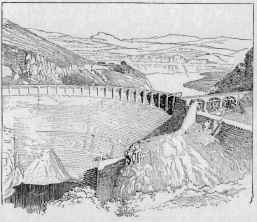
SALT RIVER IRRIGATION DAM IN ARIZONA
forests, the planting of trees, the draining of swamps, and the
irrigation of desert tracts west of the Rocky Mountains.
The total forest area in the United States at
the beginning of 1909 was so extensive that it seemed practically
inexhaustible.1 But out of every hundred acres all but
three were privately owned, and the demands made on our forests
are always increasing. We want fencing and firewood, lumber for
building, ties for railways,
1 The total extent
of forest, both public and private, was about 600,000,000
acres.
|
1900- ] |
|
387 |
and wood pulp to make into printing paper. Then again, every
year fires break out, which destroy hundreds of thousands of acres
of standing timber. For these reasons the government authorities
say that unless great care is taken our privately owned woods
however immense they may seem -- cannot last long.1
To prevent such a deplorable loss, we have now
set apart certain districts as National Forests, in order to
preserve them and so preserve the streams which rise in
them.2 A number of states do the same. Furthermore,
nearly every state has appointed one day in the year, called Arbor
Day, for tree planting. By these means it is hoped that the work
of saving the woods, and in some cases of actually creating them,
may in time prove of much benefit to the whole country.
423. What the People save; Wealth of the
Country; Gifts for the Public Good. Taking the Republic as a
whole, no nation in the world shows greater power for earning and
saving money than our own highly favored land. The first three
savings banks in America were established in 1816-1817 in
Philadelphia, Boston, and New York. In 1820 the total deposits in
these institutions amounted to but little more than $1,000,000.
To-day they reach far more than five thousand times that
sum!3 The greater part of this mass of money is the
result of years of patient toil by an army of workers who believe
in Franklin's advice, "Save and have."
The steady growth of these banks is an index of
the general growth in prosperity which is going on to a greater or
less extent among all classes. The estimated increase of the real
and personal property of the United States from 1880 to 1890 was
nearly
1 The United States
Forest Service reported ten years ago that the demand for lumber,
railway ties, wood pulp, fencing, etc. required the cutting of
over 100,000 acres of timber every day in the year. But the demand
has grown to many thousands of acres more, and it is still
growing.
2 The National Forests west of the
Mississippi River now cover about 234,000 square miles, or an area
larger than all the New England States, New York, New Jersey,
Pennsylvania, Delaware, Maryland, and Virginia combined. East of
the Mississippi we are adding National Forests in the White
Mountains and at other points along the Atlantic coast.
3 The total deposits in the savings
banks of the United States in 1909 were, in round numbers over
$3,700,000,000, and in 1916 they were estimated at $5,352,000,000.
After we entered the Great War (§ 445) many depositors bought
Liberty Bonds or War Savings Stamps.
|
388 |
|
[1905- |
50 per cent. The census returns of 1900 showed that the "true
valuation," or fair selling price, of the total property of the
country on the eve of the beginning of the twentieth century fell
only a little short of $100,000,000,000. Ten years later it was
roughly estimated by the Census Department at $142,000,000,000.
Since then it has been thought by some to be over
$200,000,000,000. These figures are so enormous that the only way
to get an idea
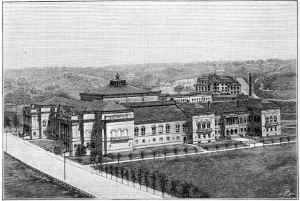
CARNEGIE INSTITUTE, PITTSBURGH
of what they actually mean is to try to count a single million,
then you will see what a task is before you.
It is pleasant to know that side by side with
this great accumulation of property there is wise and generous
giving. Ex-President Eliot of Harvard University says that no
people anywhere have equaled our countrymen in what they have done
and are doing for the support of schools, churches, and
charities.
Figures prove the truth of this statement. Not
reckoning what was contributed to churches, the private citizens
of the United States gave, in the course of a single year
(1907-1908), nearly half a million dollars for every working day,
to help forward
|
1900-] |
|
389 |
the cause of education, to establish libraries and art museums,
to endow homes for friendless children or for the aged poor, and
to build hospitals for the sick and the suffering.1 For
many years these gifts have averaged more than $100,000,000 a
year.
424. The "Open Door" in China; the Hague
Treaty. Between 1898 and 1902 five of the great nations of
Europe, with Japan, obtained control of important ports and
sections of territory in China. England wished to have all of
these made free to the commerce of the world, but the other five
nations refused to give their consent. John Hay, then our
Secretary of State, saved China from being broken up into
fragments and parceled out among the powers of Europe. He too
(1900) obtained the great privilege called the "open door." It
gave every American the same right to buy or sell goods in China
that any citizen of any foreign state possessed.
Next, the Senate accepted the Hague Peace
Conference Treaty. By this agreement the United States, with the
principal nations of Europe and with Japan, bound themselves to
maintain a perpetual Court2 of Arbitration in the city
of The Hague, the capital of Holland. The object of the Court is
to do away, as far as possible, with war between the nations which
signed the treaty.3
425. The Gold Standard Act, 1900; the Panama
Canal. When the American government first went into operation
the silver dollar was made the chief measure of value
(§§ 202, 373, 396, 400).
1 This included John
D. Rockefeller's gift of $32,000,000 for the promotion of higher
education, Mrs. Russell Sage's gift of $10,000,000 for social
service, and Andrew Carnegie's gift of $9,000,000 to the Carnegie
Institute, to which he later added another $9,000,000.
Mr. Carnegie's total American benefactions have
been estimated at over $300,000,000, and Mr. Rockefeller's, up to
1920, at $500,000,000.
From 1900 to the outbreak of the Great War in
1914, the gifts for the public good probably amounted to upwards
of $1,500,000,000.
During the war our people contributed immense
sums to help great numbers of Belgians and French and their
children, who had lost everything, and who would have perished
from hunger and cold if we had not sent them food and clothing by
shiploads.
2 In the past the United States has
settled many serious disputes with other countries by arbitration,
that is, by referring the questions to certain persons chosen to
consider and decide them. See the Alabama case (§ 374)
and the Bering Sea case (§ 406). In the same way the members
of the Hague Court have acted on cases brought to them.
3 The Hague Court decided its first
case -- between Mexico and the United States -- in our
favor.
|
390 |
|
[1900- |
In 1900 a great change took place, and, notwithstanding strong
opposition, an act was passed which made the gold dollar the
standard measure of value. Whatever other money the United States
issues must now, in all cases, come up to this standard.
Ever since we came into possession of California
there had been talk of digging a canal from ocean to ocean, either
across the Isthmus of Panama or by way of Lake Nicaragua.
Early
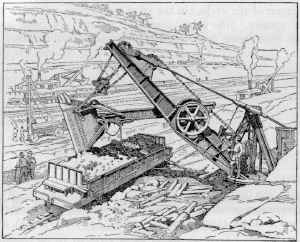
A STEAM SHOVEL AT WORK ON THE PANAMA CANAL
in the present century (1903) we made a treaty with the South
American Republic of Colombia for the right of a water way across
the isthmus; but later Colombia declined to grant it. The people
of the isthmus then declared themselves independent of Colombia
and took the name "Republic of Panama." We made a treaty with the
new republic by which we secured the use of the Panama Canal Zone,
a strip of territory ten miles in width, extending from the
Atlantic to the Pacific, for which we paid $10,000,000 besides
agreeing to pay a yearly rent of $250,000
|
1900-] |
|
391 |
more. We next purchased the unfinished French Panama Canal for
$40,000,000. We then began digging the new canal. Our trade with
the countries and states bordering on the Pacific demanded the
completion of the water way at the earliest practicable date (see
Map facing p. 380). Still further, our vessels of war needed it in
order that they might pass quickly and easily from one side of the
United States to the other, instead of having to make the long and
dangerous voyage around South America (§ 430.
426. Census of 1900. The twelfth census
(1900) returned the total population of the United States at over
76,000,000. This showed a large gain over the population reported
by the census of 1890 (§ 397).1 Figures proved
that our commerce was keeping pace with our growth in numbers.
Since then we have risen to stand at the head of the nations of
the world in the magnitude of our foreign trade (see §§
407, 424).
427. The Pan-American Exposition; the
Assassination of President McKinley. The following spring
(1901) the Pan-American Exposition2 was opened at
Buffalo, New York. It was especially designed to show the progress
made by the nations of North, South, and Central America in
agriculture, manufactures, and the arts. Furthermore, its object
was to unite all the nations of the entire American continent,
from Canada to the Argentine Republic, in closer commercial
intercourse for their common benefit.
President McKinley visited the Exposition in
September and made his last speech on that occasion. He then
expressed the hope that the exhibition might tend to bring the
United States into broader and freer trade relations with foreign
countries.
The next day (September 6), while holding a
reception at the Exposition, the President was treacherously shot
by a young man who came forward to shake hands with him. The
assassin3 was an avowed anarchist (§ 389), whose
object was to destroy the government. The wickedness of the crime
was only equaled by its folly, for our history had twice before
proved, in the case of the
1 A gain of more than
20 per cent.
2 Pan-American Exposition:
pan, a Greek word meaning "all."
3 Leon F. Czolgosz, the assassin, was
the son of an emigrant from central Europe; he was born in the
United States. he was executed at Auburn, New York, in
1901.
|
392 |
|
[1902-1904 |
assassination of President Lincoln (§ 358) and of
President Garfield (§ 381), that the murder of the chief
magistrate of the American Republic cannot overthrow the Republic
itself. Mr. McKinley died about a week later, and under the
provisions of the Constitution Vice President Roosevelt became
President.1
428. A Fourth Great Strike; the Wireless
Telegraph; the Pacific Cable; the Louisiana Purchase Exposition;
the Portland, Oregon, Exposition. In the following spring
(1902) the United Mine Workers of the hard-coal mines of
Pennsylvania struck
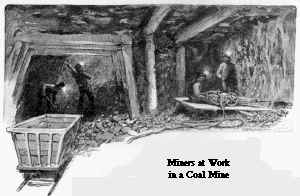
for an increase of wages and for shorter hours.2
More than 140,000 men quit work. It was the fourth great historic
strike (§§ 377, 397, 401). For the first time since the
first shovelful of hard coal was dug in Pennsylvania (§ 270),
all of these mines were shut down.
The strike lasted a little more than five
months. It was finally settled (1902) by both parties pledging
themselves to abide for three years by the decisions of a Coal
Strike Commission appointed
1 See the
Constitution, in the Appendix, p. xiv, Paragraph 5, and compare
§ 392 on the Presidential Succession Act.
2 The United Mine Workers offered to
leave the questions in dispute to the decision of the Arbitration
Committee of the National Civic Association (a body composed of
men of high standing, representing not only capital and union
labor but the interests of the general public as well). But the
managers of the coal railways declined to accept the offer on the
ground that they considered that the Arbitration Committee did not
have a practical knowledge of coal mining.
|
1902-1904] |
|
393 |
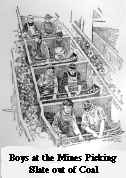 should
be equally protected in their right to labor.
should
be equally protected in their right to labor.


